by Julie Pigott Dillard | Feb 6, 2019
My very first Executive Board I was terrified! The thought of having to meet new people from across the state of Florida and having to plan an event made my stomach weak. Little did I know that my best friends would come from 4-H Executive Board weekends. I was able to make connections with people I never thought I would ever talk to, and I am so grateful that 4-H is the place where I am able to continue to make lifelong friendships. So don’t miss the chance of a lifetime.
What is the 4-H Executive Board?
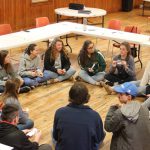
Learn more about 4-H state events at Third Exec.
The Florida 4-H State Executive Board consists of four delegates from each of the 13 4-H districts, up to 30 Executive Board Appointees, and the eight Florida 4-H State Officers. The members attend working committee meetings at Executive Board Weekends, where they offer input into our state events. Committee members also play a vital role in the implementation of those events. Other committees work on planning and implementing a state-wide community service project, fundraising, parliamentary procedure education, entertainment, and communication/marketing.

Work hard…play hard!
The Florida 4-H State Executive Board invites youth (4-H ages 13-18) to immerse themselves in the planning process behind state events including 4-H University, 4-H Legislature, 4-H Day at The Capital and Intermediate State. First and Second Executive Board sessions are reserved for those delegates appointees and state officers only, but any 4-H member can attend Third Executive Board.
Join us at Third Executive Board!
At Third Executive Board, you can expect to learn more about events you may not be familiar with. Throughout the weekend, you’ll also have to opportunity to participate in state-wide service projects, the Ways and Means fundraiser, Parliamentary Procedure contest, camp-wide games, dances, and more. The weekend of Third Executive Board is one like no other!
“Executive Board is the 4-H event that has something for everyone. It’s more than just ‘everybody is welcome.’ It’s that the event was made for them regardless of who they are or what background they come from.”
– Jared Heady – 4-H Executive Board Member, Walton County.

4-H friends are the best friends!
Third Executive Board will be held at 4-H Camp Cherry Lake in Madison, FL, on March 1-3, 2019. The cost for non-Executive Board Members is $120, and $110 for Executive Board Members. Registration for this event opens February 1, 2019 and closes February 22, 2019 in 4honline.
I hope to see you at Third Executive Board to make memories that will last a lifetime!

Kata Muellerleile, Florida 4-H State Council Reporter
Special thanks to Kata for being a guest writer this week!
For more information on 4-H in your county, contact your local UF/IFAS Extension office.
by Taylor Wilken | Feb 1, 2019
 Last year, 520 youth and 170 adults from 34 Florida counties told the 4-H story filling the state capitol with 4-H advocates. Youth educated their representatives, senators, and legislative aides on how 4-H has made an impact in their lives while experiencing the political processes of state government.
Last year, 520 youth and 170 adults from 34 Florida counties told the 4-H story filling the state capitol with 4-H advocates. Youth educated their representatives, senators, and legislative aides on how 4-H has made an impact in their lives while experiencing the political processes of state government.
A sea of green will flood the Florida’s state capitol Thursday, April 4, 2019, as Florida 4-H members, faculty, volunteers, and families participate in the annual 4-H Day at the Capitol event.

2018 attendees on the steps of Florida’s historic capitol building.
4-H Day at the Capitol
- Who: All 4-H Members, Friends, Family and Alumni
- When: April 4, 2019
- Where: Tallahassee, FL
- Cost: $15 (includes lunch and a 4-H polo)
- Registration: February 1-28, 2019 in 4-H Online
Schedule
- 7:30-8:15am – Check-in
- 8:30am – Opening Assembly
- 9:00am – Group Photo
- 9:15am – Meetings with Representatives and Senators begins
- 12:00-1:00pm – Lunch Available for Pick-up (Chik-Fil-A)
- 1:00-1:30pm – Closing Assembly
Each county is encouraged to make appointments with senators and representatives and should schedule their day how it best suits the group. For detailed information on the schedule and to prepare for the event, be sure to read the The 4-H Day at the Capitol Guidebook.
Places to Visit/Things to do
Close to the Capitol, you’ll find several things to do to fill in the rest of your day.
- Governor’s Mansion
- Knott House
- Riley House and Museum
- 4-H Day at the Capitol Scavenger Hunt
- Florida Historic Capitol Museum
- Museum of Florida History
- Big Bend Farm
- For more information, check out Explore Tallahassee
Resources
For more information on 4-H Day at the Capitol or 4-H in your county, contact your local UF/IFAS County Extension Office.
by Julie Pigott Dillard | Jan 25, 2019
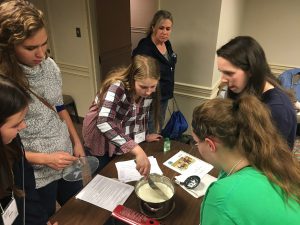
Can making mozzarella cheese really help you find your future career?
As an Extension Agent, I’ve attended numerous 4-H events through the years. Recently, I co-taught workshop at the National Youth Summit on Agri-Science at the National 4-H Center. Along with 4-H Dairy & Poultry Science Specialist, Chris Decubellis, FCS Agent, Jill Breslawski, and Dairy Regional Special Agent, Coleen Larson, we instructed 53 teens from 23 states in our two workshops!
Careers and Cheese…There’s a Connection!
Teens were introduced to agri-science during the keynote address by Mr. Ted McKinney, the Under Secretary of Agriculture for Trade and Foreign Agriculture Affairs. Summit sessions included introductions to career options and agri-science hands-on workshops. The questions and levels of interest were refreshing. I was most impressed with a young lady who expressed hesitation about attending the summit – she thought it would be solely farm-based topics. After she participated in our Exploring Dairy Science workshop (incorporating a presentation on a wide variety of careers available in the Dairy Science field and a hands-on activity making mozzarella cheese), she inquired about my career. As we discussed the vast realm of degrees one could hold to work as an Extension Agent and the wide variety of jobs available in Extension, she then shared she had found some direction for her future study in college when she entered as a college freshman in the fall of 2020.
Look Past the Title
Witnessing teens discover fields of study that meet their interests is the best reward! These type of 4-H youth opportunities help teens in so many ways. I encourage all 4-Hers to look past an event title, explore the event opportunities and keep an open mind. It could be a life changing experience!
For more information on 4-H in your county as well as state and national level events, contact your local UF/IFAS Extension office. Learn more about the Florida 4-H Dairy project.
This article was written by Marie Arick, UF/IFAS Extension Liberty County, County Extension Director & Family/Consumer Sciences Agent.
by Prudence Caskey | Jan 22, 2019
Imagine this…an appointment runs long, you skip lunch and end up snacking the rest of the day. That leads to eating dinner very late and you feeling like your whole diet and commitment to eating better in 2019 is blown! Don’t toss in the towel and give up; each new morning brings a new day and a fresh start and a chance to start over.
One of the most important skills youth learn and practice in 4-H is goal setting behavior. Here are some ways to help make goals more achievable for you and the youth in your life:
-
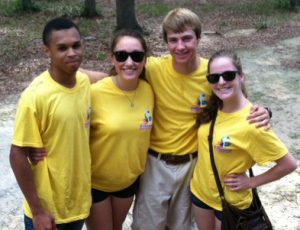
Youth are most motivated when they set their own goals.
Make goals S.M.A.R.T.
- Goals should be Specific, Measurable, Achievable, Realistic and Tangible
- Develop an Action Plan
- Write goals down
- Have an action plan to track progress
- Reflect along the way
- Make your goals present in your daily activities
- Put a reminder note on your mirror
- Set a reminder alarm on your phone
- Get an accountability partner
- Find someone you can trust to report your progress
- Check in an chat
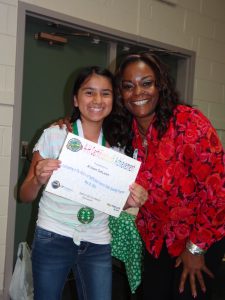
Nothing matches the look on a face when a goal is reached!
My son is my physical activity accountability partner, and he and I walk together. Sometimes he has to drag me out of the house, and sometimes I have to get him motivated to go – whatever it takes to meet your goals.
Remember, every day is new with the opportunity to start fresh each day. Make a New Day Resolution to achieve your goals. If you fell off the wagon yesterday, let it go. Best wishes for a great new year and for every new day you have!
For more information on 4-H in your county, contact your local UF/IFAS Extension office.
Resources: How Setting Goals Helps Teens Succeed
by Jena Gilmore | Jan 18, 2019
While this year’s hunting season is winding up, it’s never too early to think about getting ready for next year. Whether it’s deer, squirrel, ducks, dove or turkey, there are important hunting rules and guidelines both youth and adults must follow. Organizations like the Florida Fish and Wildlife Conservation Commission (FWC) and your local UF/IFAS Extension Office provide programs to keep you on target each hunting season!
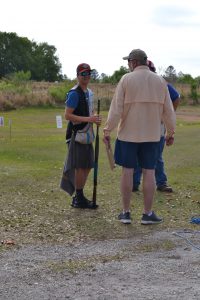
Safety is a key element of any shooting sport.
SAFETY FIRST
Each hunter must take some version of the Hunters Safety Education course. Anyone born on or after June 1, 1975, and 16 years or older, must pass a hunter safety course before a hunting license can be purchased. There are four options to complete this requirement:
- Traditional Course and Skills Day
– Face-to-face instructor led course
– Hands-on skill day – register here
- Online Course and Skills Day (two part process)
– Complete one of the online courses
– Hands on skill day – register here
- Florida Virtual School Outdoor Education
– FREE to Florida students in grades 9-12 or ages 12-18
– Apply here
– Earn 0.5 credit for high school
- Firearms Safety Certification and Online Course
– Adults only
– Must have completed previous firearms training
– Must complete one of the online classes in Option 2
– Follow procedures outlined in the Application for Hunter Safety Certification
If you’re using the Hunter Safety Mentoring Exemption and hunting under the supervision of a qualified hunter, you are exempt from this requirement.
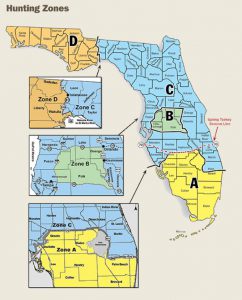
Our district covers Zone D – Escambia to Gadsden/Wakulla & Zone C – Leon & Jefferson. Map courtesy of FWC.
Find Your Zone
Hunters should strive to be good stewards of Florida’s resources to keep this sport a tradition for generations to come. Take the time to determine what hunting zone you live in. Your zone determines your hunting season – meaning the appropriate time you can collect specific game in that area. You can find the Florida Hunting Zones Map here: http://myfwc.com/hunting/season-dates/zone-map/. Next, check the annually updated hunting season dates and bag limits related to your zone to stay in compliance with FWC regulations: http://myfwc.com/hunting/season-dates.
4-H Shooting Sports
Find your local UF/IFAS Extension Office and determine if there is a 4-H Shooting Sports program in your county. Participation in a 4-H Shooting Sport program provides year-round opportunities for youth to not only practice their discipline but also to explore other disciplines in a safe, inclusive, environment with 4-H volunteers/mentors!
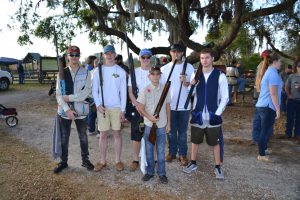
4-H grows important life skills like responsibility, goal setting and teamwork in youth through shooting sports.
4-H Shooting Sports includes air rifle, small bore rifle, archery, shotgun, muzzleloading and hunting and develops important life skills in a safe and educational environment. Shooting sports day camps are popular during the summer, so ask you 4-H Agent if one will be scheduled for you county.
Attention Volunteers!
Would you like to become become 4-H Level 1 Certified to coach and teach youth shooting sports? If you are already enrolled as a 4-H volunteer, log in to your profile and register for the February 16th hands-on training in shotgun and archery. You’ll also complete five online learning modules as part of your training. If you’re new to 4-H, enroll at florida.4honline.com, and let your county 4-H Agent know that you are interested in teaching shooting sports.
Explore the links below to see how you and your youth can get involved in 4-H and stay up to date on the hunting regulations for your area:
by Melanie Taylor | Jan 11, 2019

Be mindful and enjoy the moment.
Now that the busy holiday season is over, it’s a time to reflect on the past but prepare and refocus for the new year ahead. As we focus on the new year, it is always refreshing to have a clean slate. As the year begins to unfold, there are tips to help you manage your day-to-day stress levels. It begins with mindfulness.
What is mindfulness?
Mindfulness means paying attention in a particular way; on purpose, in the present moment, and non-judgmentally.” Dr. Jon Kabat-Zinn (1991)
Mindfulness is best thought of as a way of being rather than an activity Almost any activity can be carried out with mindful awareness.
Three Key Features of Mindful Awareness:
- Purpose – intentionally and purposefully directing your attention rather than letting it wander.
- Presence – being fully engaged with and attentive to the present moment. Thoughts about the past and future that arise are recognized simply as thoughts occurring in the present.
- Acceptance – being non-judgmental toward whatever arises in the moment. This means that sensations, thoughts, and emotions are not judged as good or bad, pleasant or unpleasant; they are simply noticed as “happening” and observed until they eventually pass (Naik, Harris and Forthun 2016).
Mindfulness is a mind-body practice that has been found to benefit both psychological and physical health. The primary psychological change that occurs during mindfulness practice is an increased awareness of thoughts, feelings, and sensations in the present moment. Over time, mindfulness practice can help you to become aware of the space between noticing experiences and reacting to them by letting you slow down and observe the processes of your mind (Black 2010).
The ultimate goal of mindfulness practice is for you to take advantage of this space so you can make more intentional decisions – to wake up from living life on autopilot, based on unproductive habits of mind
(Black 2010; Walach et al. 2007).
According to the American Psychological Association, some empirically supported benefits of mindfulness include the following (Davis & Hayes 2011):
Psychological Benefits
- Increased awareness of one’s mind
- Significantly reduced stress, anxiety, and negative emotions
- Increased control over ruminative thinking (a major cause and symptom of depression and anxiety)
- Increased mental flexibility and focus
- More working memory
- Decreased distracting thoughts
- Decreased emotional reactivity
- Increased capacity for intentional, responsive behaviors
- Increased empathy, compassion and conscientiousness of other’s emotions
Physiological Benefits
- Enhanced immune system functioning
- Increased brain density and neural integration in areas responsible for positive emotions, self-regulation, and long-term planning
- Lowered blood pressure
- Lowered levels of blood cortisol (a major stress hormone)
- Greater resistance to stress-related illnesses such as heart disease
Spiritual Benefits
- Increased self-insight and self-acceptance
- Increased acceptance of others
- Increased compassion and empathy
- Increased sense of morality, intuition, and courage to change
- Increased control over automatic behaviors
- Increased self-discipline
The question is, how many of us would like to benefit from mindfulness if it provides these positive benefits? All of us should strive to lower our stress level and enjoy our daily lives with a more positive attitude and more attentiveness. So, how can we incorporate this into our lives? The majority of this practice is about familiarizing yourself with what it feels like to be mindful, and getting better at “remembering” to maintain mindful awareness.
Experiment with creating your own mindfulness practices throughout your day. Being mindful of the sensation on the soles of your feet as you walk to your car or the taste and texture of your morning coffee can transform routine moments into deeply satisfying practices. However, having a ritualized and structured practice can be beneficial. To find out more about practicing mindfulness and how to incorporate a more structured practice in your life visit read Mindfulness: An Introduction.
Sources: Mindfulness: An Introduction. 2013, 2016. Retrieved from the UF/IFAS Extension Electronic Data Information System: https://edis.ifas.ufl.edu/fy1381. Publication #FCS2335
by Whitney Cherry | Jan 4, 2019
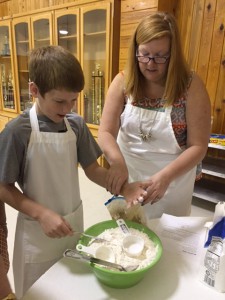
Cooking together makes memories that last longer than gifts. Photo: Monica Brinkley
This is one New Year’s resolution that I can get behind –
give less stuff and give more self. We’ve just wrapped up December – a month of massive giving. We gave gifts, we made charitable monetary donations, and we’ve overdone “bake-and-take” as I call it. It takes a lot of expendable income to give so many things, but you can choose to manage your resources wisely throughout the year and give through acts of service instead.
I particularly love this idea with small children who may want to buy gifts for loved ones but who aren’t old enough to earn money yet, but it works great for kids of all ages. Rather than doing coupon books for hugs and kisses (cute and welcome as those may be), I help them arrange to spend part of a day with a loved one instead. They help with household chores, do some baking or cooking with them, tackle a difficult chore and so on. Not only are they helping with age appropriate tasks, but they’re getting to spend time together and make memories.
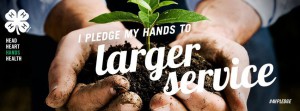
Encourage youth in your life to look around during the year and see who needs help and what they can do to help. Instead of giving more stuff, give more self.
4-H teaches youth life skills such as planning/organizing, wise use of resources, social skills, and character. By encouraging 4-H youth to serve in any large or small way they can, we help them build these and other crucial life skills. Find your local UF/IFAS Extension office to explore how 4-H teaches youth valuable life skills through its project areas..
by Niki Crawson | Dec 21, 2018
Did you know lack of organization in your life can affect not only your physical surroundings but also your physical and mental well-being? Clutter affects your ability to think, to focus, and even to relax. For children, having an organized space for homework allows for productivity and creativity. For adults, having an organized work space allows for productivity and efficiency. Having an organized home for children sets schedules and routines. For adults, having set schedules and routines make it easier to balance work, family time, and responsibilities such as financial planning and grocery shopping.
To start 2019 off on a positive note, let’s take a look at some easy ways you can get better organized for a better you in 2019.
1. SET GOALS
Goal-setting is an important life skill 4-H focuses on through the essential element, Independence. 4-Hers are taught goal-setting – an important tool that helps them state how, what, and when they are going to achieve something. To get started organizing and decluttering your home:
- Set 2-3 short-term goals
- Set 1-2 long-term goals
- Write them down – make them visible
Anything more than this will be too overwhelming and cause you to not start at all.
2. MAKE LISTS

Making a handwritten detailed to do list is important in staying organized.
Written lists are very important in accomplishing tasks. Most importantly, hand-written lists are more powerful than typed lists. Why? Handwriting requires more thought and motor skills which requires more cognitive and memory function. By having written to do lists, your memory can conjure up the tasks quickly and prioritize them with little effort even when the list is not directly in front of you. This allows you to plan your schedule to work on the list throughout the day, when time permits. In addition, writing lists allow the satisfaction of achievement. When you accomplish a task, cross it off the list and feel the sense of accomplishment that comes with getting things done.
3. DIVIDE AND CONQUER
One of the worst things you can do when attempting to organize a cluttered home is to look at the disorganized mess as a whole. This can be overwhelming, defeating and make you give up before you even get started! Don’t do this…instead, divide and conquer!
- Start by dividing your home into sections.
- Choose one room to start with.
- Start with just one section of that room – like the top of the dresser.
- Organize just that one area. Donate or sell any items you do not want or use.
Once you have organized your first area in that room, congratulate yourself and move to the next area. Begin the process again!
CUT CLUTTER WITH A CLOSE FRIEND
If you think getting organized is complicated, invite an organized friend over, and ask them to help. Organized individuals will help you stay on track, discard what you don’t need, and help you find a place for those random items you don’t know where to put. Some people just have a natural ability for organization, but for others, it’s just plain work.
ELIMINATE DUPLICATES
I’ve moved several times in recent years.The last time I was unpacking (for what I hope is my last move), I discovered I have nine hammers. Nine hammers!!! Apparently, each time I moved, I couldn’t find my hammer, so I just bought one. Over time, that gets expensive and takes up space. As you begin to organize and declutter, eliminate duplicates. Think about what you need and begin to downsize. You’ll be amazed at what you truly need versus what you think you need.
SAY GOODBYE…
If you haven’t used it in the last six months but don’t want to get rid of it just yet, box it up and label it with the date. If three months goes by and you don’t miss it, donate or sell it. Yard sales, selling apps or social media are a great way to make some extra money , BUT don’t hang on to it until you “get around to it….” Donate it to charity, or you’ll end up back in the cluttered mess you started with!
Simply taking the time now to put these few actions into place will help create a more efficient, better balanced and stress-free environment in the home and workplace. I hope that you find yourself healthier and happier in 2019!
To find out more information about 4-H programs that can offer essential life skills such as independence, organizational skills, and goal setting, to your children or to volunteer your time to work with children in your area, please contact your local UF/IFAS County Extension Office, or visit http://florida4h.org.
by Melanie Taylor | Dec 14, 2018

Aim to find JOY in this holiday season.
As the holiday season quickly approaches, many people are filled with extra holiday cheer and enthusiasm. Some are jolly but still overwhelmed with all of the activities, decorating, and shopping that needs to be completed. Then, there are those that find the holiday season as a reminder of things such as the death of a loved one, family feuds, divorce…the list goes on. If you are feeling this way, here are a few tips to make getting through the season a little bit easier.
- Feel your emotions – Many people want to suppress their sadness or anxiety, but this only makes it worse. We are all allowed to grieve, cry and feel mad at times. If you feel this way, let yourself feel your feelings. You will feel better once you have accepted and worked through the emotions. You also do not have to force yourself to feel happy just because it is the holiday season.
- Reach out to others – Instead of secluding yourself, spend time with others whether it’s at church, a community group or with family and friends. Spending time with others and socializing is good for the spirit.
- Volunteer – There are tons of volunteer opportunities during the holidays. Try something new and volunteer your time to a worthy cause. You’ll feel great about helping others and contributing to a cause.A national survey commissioned by UnitedHealth Group talked to 3,351 adults and found the majority of participants reported feeling mentally and physically healthier after a volunteer experience.
The research showed:
* 96% reported volunteering enriched their sense of purpose in life
* 94% of people said volunteering improved their mood
* 80% of them feel like they have control over their health
* 78% of them said volunteering lowered their stress levels
* 76% of people said volunteering has made them feel healthier
* About a quarter reported their volunteer work helped them manage a chronic illness by keeping them
active and taking their minds off of their own problems
* Volunteering improved their mood and self-esteem
- Be realistic – Realize that times and traditions change as families grow and age. Do not focus on things having to be the same every year. Be willing to accept changes, such as adult children may not be able to attend the family gathering, so utilize technology and talk through video conferencing, share pictures on email and/or Facebook. Find a way to make it work.
- Set aside differences for everyone’s sake. Aim to accept family and friends the way they are, even if they do not meet your expectations. Leave grievances at the door for the day and enjoy your family and friends. Share those grievances and talk at a more appropriate and private time. Also, remember they could be feeling the stress of the holiday too. So, be patient if someone is grouchy or sad as you celebrate. You may both be feeling the same way.
- Learn to say no – Be realistic in the number of activities you and your family can participate. Do not feel guilty because you cannot attend every party and event you are invited too. Graciously decline an invite and share that your schedule is booked, but thank them for thinking of you. A host does not expect that everyone will attend their parties.
- Take a breather as needed – If you start to feel overwhelmed with anxiety, anger or sadness take a few minutes to be alone. Take 15 minutes to spend in the quiet to reduce the stress and clear your mind. For example: listen to soothing music, do a few mindful breathing exercises to slow yourself down or read a book to temporarily escape the stress.
- Seek professional help as needed – there are times when the emotions are just too overwhelming to sort through on our own. If you continue to feel sad, anxious, angry, etc. there is absolutely no shame in seeking the help of a doctor or mental health professional. It will only help you work through your feelings with a non-bias person. Helping yourself feel better will improve your quality of life and those around you.
Learn to take care of yourself first. Learn your limitations and accept them. Don’t t let other’s expectations overwhelm you. Just remember when you start feeling extreme levels of emotions and/or stress, take a few deep breathes and remind yourself to relax and feel the moment. Be mindful of your surroundings and remind yourself of your many blessings even when going through difficult times. Make it your personal goal to feel your feelings and enjoy what you can about the holiday season whether it is the twinkling lights, time with friends and family, the food or any of the many special holiday traditions.
Striving for and maintaining a healthy lifestyle is an achievable goal and a National 4-H Council mission mandate for all of our 4-H members, families and volunteers. To learn more about healthy lifestyles and 4-H, find your local UF/IFAS Extension office.
Sources:
by Rachel Pienta | Dec 12, 2018
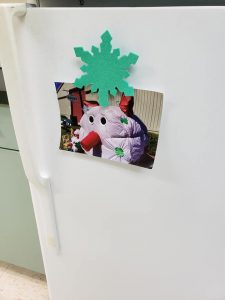
Here’s an example of a decorated clothespin magnet holding a photo.
Slow Down to Savor the Season
The weeks leading up to the gift-giving holiday season can be hectic and stressful. Full social schedules and crowded stores can make Christmas seem like an expensive chore. One way to restore some of the joy of the season and regain some valuable family time is to make thoughtful giftsathome.
Craft a Gift That Everyone Can Use
Every year, the postal service brings glossy family photo cards to my home from friends near and far. Our family likes to make them part of the festive décor for the holiday season by displaying them with homemade r refrigerator magnets. This magnet craft is one you can make with your entire family or at a 4-H Club meeting and give them as gifts.
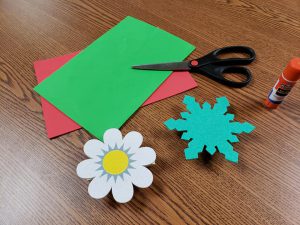
Foam board cut outs can be glued to the clothespin to make fun magnets to give as gifts.
Basic Items to Get Started
Square wooden clothespins
Glue
Scissors
Adhesive magnet strips
Craft foam sheets
Markers
Glitter
Ribbon
We have decorative magnets and like to rotate them with the season. Decorative details are limited only by your imagination and the weight that the magnets will support. Trial and error with magnet strength is recommended and is a great way to spark a STEM discussion while creating art together!
Follow these simple instructions:
- Measure the magnet strip to cover the “back” of the clothespin.
- Cut to length. (Adults may need to help younger kids with this.)
- Attach the magnet strip to the “back” of the clothespin.
- Add decorations or art work like foam cutouts to the “front” of the clothespin.
Gift Ideas
- Packaging the magnetic clothespins with a family photo or a child’s artwork.
- Using a decorated clothespin magnet to hold a gift tag and include with a larger wrapped gift.
- Giving cookies or other baked treats? Clothespin magnets make great recipe holders!
4-H is a great place for your child to express their creativity. For information about 4-H in your county, please click here.
Additional Ideas & Resources for Clothespin Magnets
DIY Clothespin Magnets!
https://www.diynetwork.com/how-to/make-and-decorate/crafts/how-to-make-refrigerator-magnets-from-clothespins
Teachers Gifts: DIY Magnetic Clothespins



















